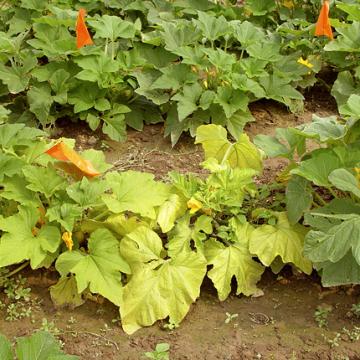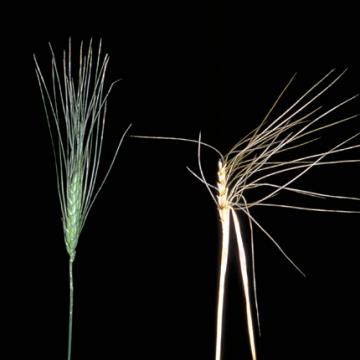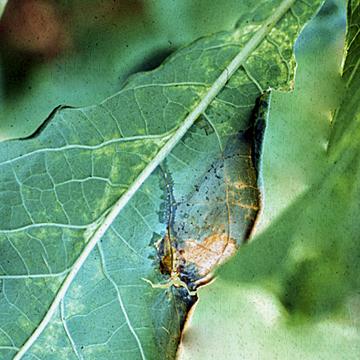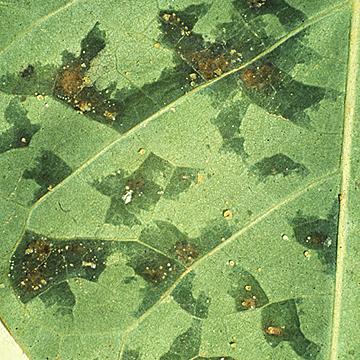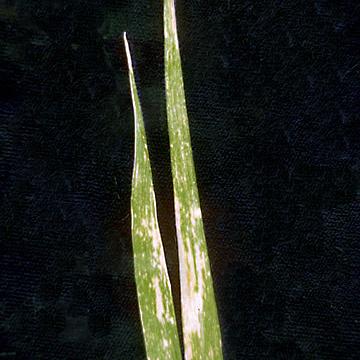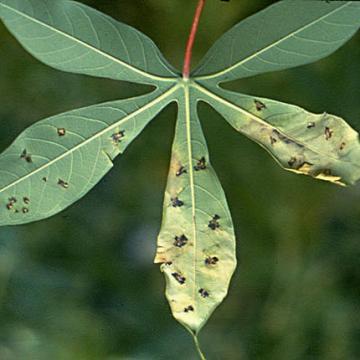DISEASE: Aster yellows
HOST: Squash
Diagnostic characteristics for the disease are yellowing of young leaves, proliferation of secondary shoots, and rigid erect habit. Leaves are misshapen and smaller than normal and have stiff, thick laminae.
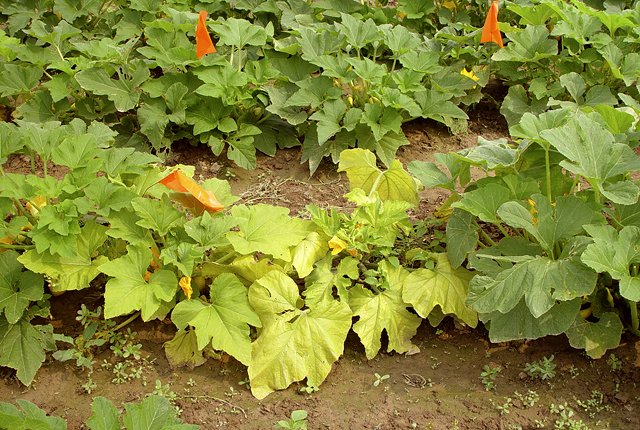
Aster yellows | Squash
DISEASE: Aster yellows
HOST: Squash (Cucurbita sp.)
PATHOGEN: 'Candidatus Phytoplasma asteris'
PATHOGEN SYNONYM: Phytoplasma Aster yellows group
SOURCE: S. Miller
DISEASE: Aster yellows
HOST: Wheat
Healthy head (left) and diseased head (right). Diseased seedlings may die within 2 to 3 weeks. Infected heads of surviving plants are small and sterile, with distorted awns.

Aster yellows | Wheat
DISEASE: Aster yellows
HOST: Wheat (Triticum aestivum)
PATHOGEN: 'Candidatus Phytoplasma asteris'
PATHOGEN SYNONYM: Phytoplasma Aster yellows group
SOURCE: L. N. Chiykowski
DISEASE: Bacterial blight
HOST: Cassava
Leaf with angular, water-soaked, vein-delimited lesions.
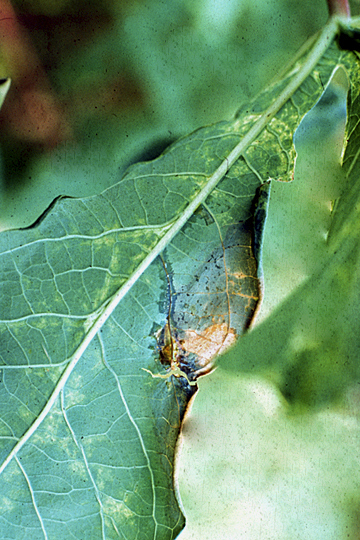
Bacterial blight | Cassava
DISEASE: Bacterial blight
HOST: Cassava (Manihot esculenta)
PATHOGEN: Xanthomonas axonopodis pv. manihotis
PATHOGEN SYNONYM: Xanthomonas campestris pv. manihotis
SOURCE: A. Hayward
DISEASE: Bacterial blight
HOST: Cassava
Cassava with angular leaf spots and yellow ooze. Symptoms include leaf spots, wilt, and dieback. The bacterium frequently invades systemically.

Bacterial blight | Cassava
DISEASE: Bacterial blight
HOST: Cassava (Manihot esculenta)
PATHOGEN: Xanthomonas axonopodis pv. manihotis
PATHOGEN SYNONYM: Xanthomonas campestris pv. manihotis
SOURCE: A. Hayward
DISEASE: Bacterial leaf blight
HOST: Wheat
Diseased leaves with whitish blotches. Initial water-soaked spots become necrotic and progress from gray-green to tannish white.
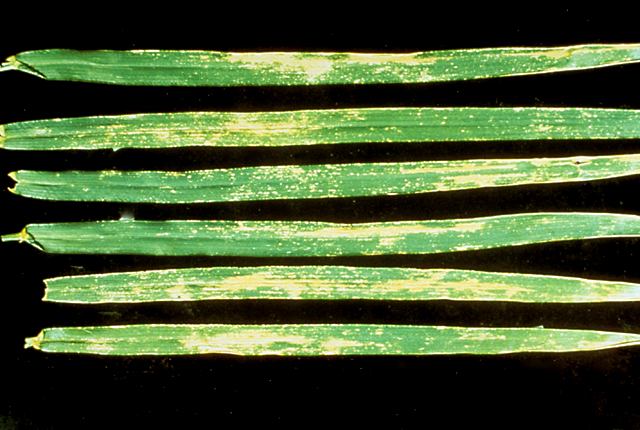
Bacterial leaf blight | Wheat
DISEASE: Bacterial leaf blight
HOST: Wheat (Triticum aestivum)
PATHOGEN: Pseudomonas syringae pv. syringae
SOURCE: J. Otta
DISEASE: Bacterial leaf blight
HOST: Wheat
Diseased leaves with whitish blotches. The disease begins as water-soaked spots and then become necrotic and progresses from gray-green to tannish white.

Bacterial leaf blight | Wheat
DISEASE: Bacterial leaf blight
HOST: Wheat (Triticum aestivum)
PATHOGEN: Pseudomonas syringae pv. syringae
SOURCE: L. Claflin
DISEASE: Bacterial leaf blight
HOST: Wheat
Leaves with reddish tan necrotic lesions.
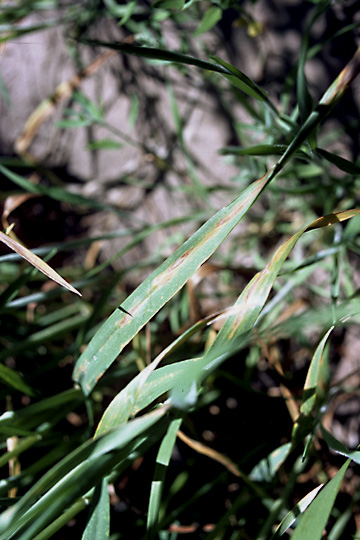
Bacterial leaf blight | Wheat
DISEASE: Bacterial leaf blight
HOST: Wheat (Triticum aestivum)
PATHOGEN: Pseudomonas syringae pv. syringae
SOURCE: L. Claflin
DISEASE: Bacterial leaf spot (Bacterial necrosis)
HOST: Cassava
Cassava with yellowish leaves and water-soaked, angular spots. The disease is primarily on foliage, although the pathogen may invade stem buds and young branches.
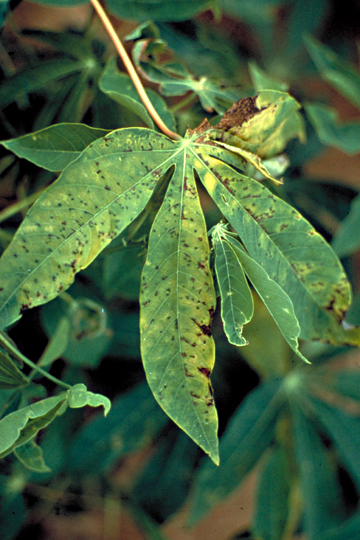
Bacterial leaf spot (Bacterial necrosis) | Cassava
DISEASE: Bacterial leaf spot (Bacterial necrosis)
HOST: Cassava (Manihot esculenta)
PATHOGEN: Xanthomonas cassavae
PATHOGEN SYNONYM: Xanthomonas campestris pv. cassavae
SOURCE: APS
DISEASE: Bacterial leaf spot (Bacterial necrosis)
HOST: Cassava
Cassava with brownish lesions and blackish edges. Leaves turn yellow with multiple infection sites.
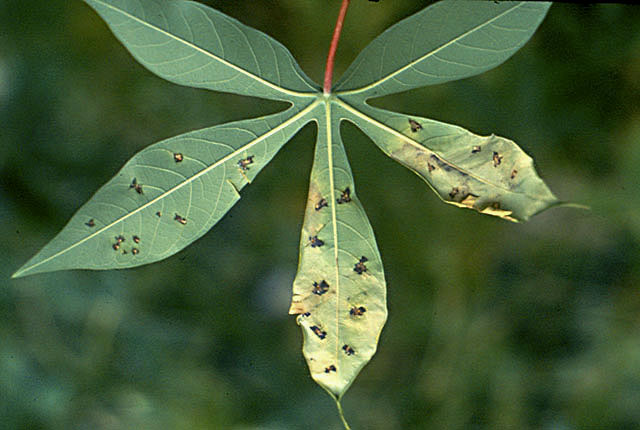
Bacterial leaf spot (Bacterial necrosis) | Cassava
DISEASE: Bacterial leaf spot (Bacterial necrosis)
HOST: Cassava (Manihot esculenta)
PATHOGEN: Xanthomonas cassavae
PATHOGEN SYNONYM: Xanthomonas campestris pv. cassavae
SOURCE: H. Maraite, A. Alvarez


